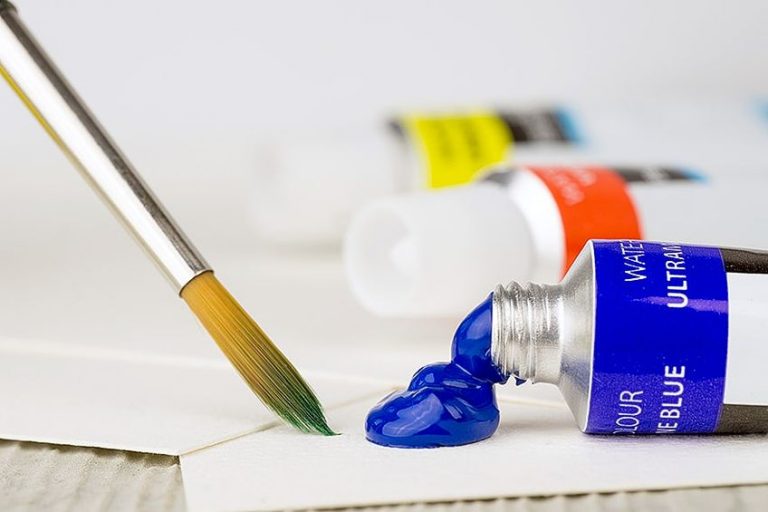Can You Mix Acrylic and Oil Paint? – Properties of These Paints
Can you mix acrylic and oil paint? This question has been asked by artists and DIY enthusiasts for many years. The reason for this is that you may want to include both paints in a special art project to capture some unique painting techniques. Whatever your purpose, in this article, we will be explaining what you need to know, and how to use both paints effectively.
Can You Mix Acrylic and Oil Paint?
Is acrylic paint oil based? No, acrylic paints are water-based, while the oil paints are oil-based. Both paints have their own properties and characteristics. The main aspect is that water does not mix well with oil, therefore, it is not recommended that you mix acrylic and oil paints. However, you can still use acrylic and oil paints together in an art project.
You can paint with one type of paint first and then apply the other paint afterward.

The only way to do this is to first paint with the acrylic paint, allow it to dry, and then you can safely apply the oil paint over it. Never paint a layer of oil paint and then acrylic paint over it, as the acrylic paint will not be able to adhere properly to the oil paint layer and the paint will start to flake and peel off. This may happen suddenly, or it can take weeks, but at some time the paint will flake off. Let us now take a closer look at each type of paint.
What Are Acrylic Paints?
Acrylic paint is a synthetic polymer that has a water-based composition, which means it can easily dissolve in water and is made up of minute particles that contain acrylic resins that are suspended in water, together with pigments. When the water in the paint begins to evaporate the resins fuse and form a strong bond, producing a durable paint surface.
Properties of Acrylic Paint
Is acrylic paint oil based? The main feature of acrylics is that they are water-based. Acrylic paint is a very versatile medium, water-soluble when wet, and it is non-toxic. It has a plastic polymer, allowing it to dry into a water-resistant, durable, and flexible paint surface. This allows you to add other layers of paint without disturbing the underlying layers of paint.

- These paints remain water-soluble when they are still wet.
- Once they have dried out, the acrylic paint becomes flexible and permanent.
- The painted surface is free from any cracks or chips.
- Acrylic paints are fast drying once the water has evaporated. This takes from 10 to 20 minutes or three days for complete drying.
- Acrylic paint is easy to apply for those special blending techniques and leaves you with a smooth durable surface.
- The paints are very easy to clean by using soap and warm water, which includes the brushes, as long as the paint has not dried completely.
- There are zero odors and fumes, and it is also non-flammable.
- There is a variety of amazing vibrant paint colors available.
- This type of paint is versatile and can be used on various surfaces that include wood, metal, canvas, and much more.
Types of Acrylic Paints
Besides artist and student-grade acrylic paints, there is a variety of acrylic paint types. Some of them are specially designed to use with oil paints, while others need to be used on their own. You can mix it with other mediums, giving you different drying times, textures, and adhering properties Here are the different types of acrylic paints and what you can use them for.
Heavy Body Acrylic Paint
This paint is thick and creamy, making it ideal for creating various textured effects. It dries fast and is very versatile and can be used on canvas, wood, and even on metal. You can experiment with different effects by applying it straight from the tube or mixing it with a medium.

Fluid Acrylic Paint
Fluid acrylic paint is a much thinner paint and is ideal for creating even smooth layers of paint. They also dry very fast, and because they have high pigmentation, they can be used on many different types of surfaces. These paints can create a variety of looks and they can also be mixed with other acrylic mediums.
High Flow Acrylic Paint
This type of acrylic paint is especially known for its very thick consistency and can be used to create many textured effects as well as layers of paint, but it is also very difficult to control. This type of acrylic paint is very expensive and is used mainly by experienced artists that want to work with a very versatile medium.

Medium Viscosity Acrylic Paint
In terms of consistency, this type of acrylic paint falls between the heavy body and fluid acrylic paint types and is ideal for creating smooth as well as textured effects. They are fast-drying paints with good pigmentation and can be used on a diverse range of surfaces.
Low Viscosity Acrylic Paint
The low-viscosity acrylic paint is much thinner than the fluid acrylic paint and can very easily be mixed with oil paints but will not mix well at all with any other thicker paints. It is ideal for glazing or painting thin layers of paint.

Pros and Cons of Using Acrylic Paint
Acrylic paint is a relatively new discovery in the art world, unlike oil paints and watercolors, which have been around for decades. Many artists are using it because it is so versatile, with vibrant colors, and for its durability and stability. However, like all other products, it has its advantages and disadvantages.

PROS
- It dries very fast
- Acrylic paint is versatile
- Can be applied to numerous surfaces
- Acrylics are not toxic
- The paint is water-based and easy to clean off your hands and brushes
- It is a lot more affordable
- Has vibrant colors
- Is very durable, and will not crack, peel off, or yellow
- It is also water-resistant once dry
CONS
- Once properly dry, it is very difficult to remove
- Your time is limited for completing a task before it dries
- Once dry, the color appears darker
- For collectors and art galleries, the paintings are less valuable
Common Uses of Acrylic Paints
Acrylic paints are non-toxic, water-based, and quick-drying, and can be used for various applications. Acrylic paint is ideal for both indoor and outdoor use. The paint is also durable, which means it lasts long without cracking or fading.
Acrylic Paint for Crafts
Acrylic paint is ideal for arts and crafts as it is cheaper, has a creamy consistency, is quick-drying, and comes in a variety of colors. It is also very versatile and can be
You can also get glitter, metallic, chalkboard, or glow-in-the-dark paints, making your hobby come alive.
Acrylic Paint for Home Improvements
Latex paint is an acrylic-based paint that is suitable for use on interior or exterior walls and ceilings of your home. It comes in a large variety of finishes including high gloss and matte. Most latex paints will dry to the touch within an hour, but you need to allow the paint to dry properly before applying the next coat. However, although the paint appears to be dry to the touch, it may take a couple of weeks before the paint surface is ready to take on the daily wear and tear.
It is best to use a primer before you paint, as it will increase the durability of the paint and keep the color constant.

Acrylic Paint for the Artist
For the artist, there are student-grade acrylic paints, which are much cheaper. However, the paints have lower durability and quality. The artist-grade acrylic paints are more expensive, but provide much better consistency and vibrancy, as well as better control when being used.
The fluid acrylic paint is used when more detailed work is required.

It provides much smoother borders and edges and dries quickly, allowing the artist to add extra layers very fast. The heavy-body acrylic paint is a lot thicker, allowing the artist to make better brush strokes and textured work. It also dries slower, making color mixing easier.
What Are Oil Paints?
Oil paints were developed in the 12th century, and are responsible for creating many of the most famous paintings in history. They are oil-based, and their chemical composition contains pigments suspended in oil, normally linseed oil, but they also make use of poppyseed, walnut, and safflower oil. Oil is the binder for the color pigments.
Properties of Oil Paint
Oil paint medium has a much slower drying rate with greater flexibility, and can produce different effects of opacity, gloss, and transparency. Oil paints are not compatible with water and require more work to clean, using a solvent, such as turpentine.

- Oil paints have a greater richness of color, with tonal transitions, and a wide range of shades.
- The paint is slow drying, which allows the artist to work for longer to achieve the desired result.
- They come in matte and gloss finishes and can produce opaque and transparent effects.
- Oil paint colors will not fade after drying.
- The oil paint will not flake or peel off as it dries.
- You cannot use the same oil brushes to paint with acrylic paints.
- When working with oil paints, they tend to release some toxic fumes.
Types of Oil Paints
Not all oil paints are the same, there are two main types of oil paints, which are the artist-grade or professional-grade, and the student-grade. Let us have a look at the differences between these two types of oil paints.
Artist Grade Oil Paint
Also known as the professional grade, it contains a much higher pigment content, making the colors richer and purer. The viscosity is creamy and thick, making it harder to apply to your canvas. However, it covers well, making your painting more vibrant and bolder due to the lack of fillers in the paint. The lightfastness of the oil paint can retain the vibrancy and true color for a long time.
The colors always remain true even after mixing, and although it may be more expensive, it will improve the quality and intensity of your painting.
Student Grade Oil Paint
The student-grade oil paint usually has a very low percentage of pigments, which compels the manufacturers to add more fillers like chalk and oil. These additional filters reduce the cost of the paint, making it a lot cheaper to buy. However, it also makes the student grade of oil paint lower in quality, forcing you to use more paint to obtain vibrant tones and colors. The lightfastness is also a lot less, causing the paint to fade over time.
Pros and Cons of Oil Paints
In the past, the artist only used oil paints as this was the only choice available. However, today you have the choice of acrylic and watercolors as well. The application of oil paint involves some skill, but you can create a realistic and versatile painting.

PROS
- Longer drying time, so an artist can make changes
- Oil painting provides a wider range of rich colors
- Can be used on a variety of surfaces
- With oil paints, you can make thin glazes or thicker impastos
- There is a variety of oil paint finishes available
- Oil paints are consistent with no change in color or texture when dried
CONS
- Longer drying times may be a disadvantage for some artists
- Oil paints are easy to blend, but can result in unclear and muddy colors
- Most surfaces require a primer
Common Uses of Oil Paints
Oil paints have several ingredients, which include natural oils like linseed oil. The oil in the paint is there to bind the paint and help dry the paint when applied. Oil-based paints need to be used where you want the paint to last and stand the test of endurance.
Oil Paint for Crafts
If you are looking for a durable paint, then oil paint is the answer, as it will provide you with a rich, glossy finish, and smooth surface that lasts. Oil paints are versatile and can be applied to several surfaces like canvas, wood, cardboard, paper, stone, brisk, plaster, metal, and fabric like T-shirts, and many more. With all of these benefits, oil paint can be used for any crafting, but is not the best choice to use when kids are involved.
However, remember the paint will take time to dry, which can be an advantage if you want to correct a mistake but can also be a disadvantage, making you wait a long time before you can go on to the next step.
Oil Paint for Home Improvements
Oil-based paint or enamel paint is an excellent choice for many surfaces around the home, giving you a strong, durable, and glossy finish that is water and stain resistant once dry. It is ideal for windowsills, door casings, and walls that need protection, especially in high-traffic areas, and is easy to keep clean. It is also perfect for use in bathrooms, and kitchens where humidity and wetness are an issue, and for high-temperature areas like outdoor grills and kitchen appliances.
It is also an ideal paint to use for outdoor furniture that needs to withstand the elements and UV rays every day.

Oil Paint for Artists
Oil paints were the only type of paint the early artists knew and have been used ever since by all artists, because of their many advantages oil paints are the only paints that many artists use to give them the desired textures and techniques to give them the finish they want.
Difference Between Oil and Acrylic Paint
When you squeeze oil or acrylic paint from the tubes, they both appear to be the same, but there are fundamental differences between these two types of paint. Both the paints have their pros and cons, so what makes the difference so prominent between them both? Let us show you in the table below.

| Properties | Acrylic Paint | Oil Paint |
| Drying Time | Very fast drying time | Very slow drying time |
| Lightfastness | Will not fade or yellow over time | Will fade and yellow over time |
| Texture | Shows brush strokes and requires many layers to remove | Shows no brush strokes and always gives a smooth finish |
| Longevity | Anything from two to 15 years | 30 to 100 years |
| Application | Easy to apply even over old paint | Needs preparation, old paint must be removed before applying paint |
| Color options | Many color options are available, and they are easy to mix | Not many colors are available, and it is difficult to mix |
| Safety | Non-toxic, safe to use even with children | Toxic, needs to be sealed or protected, and safety precautions need to be applied |
| Thinning and cleaning | Needs only water to thin and clean | Needs a solvent like white spirits to thin and clean |
| Glazing and layering | Easy and quick | Difficult and takes time |
What to Expect When Mixing Oil and Acrylic Paints?
Oil paints are oil-based, while acrylics are water-based, and water cannot mix with oil. So, when mixing oil with acrylic paint, the oil will separate as the oil is not as dense as water. The oil paint also dries slower, so it will not mix properly. What will happen when mixing oil and acrylic paint?

- The two types of paint will not combine when mixed, which will leave you with a dispersion of the two paints.
- It takes a lot of time to mix them well and will still not mix completely.
- Because the drying time of the two paints is not the same, the paint will ultimately crack.
- The mixture will not be durable and will not stick to the surface, but can easily be peeled off.
- Over months or years, the binders spread out and will stain the paper or surface.
Benefits of Mixing Oil and Acrylic Paints
Can I paint acrylic over oil? This will leave you with a painting that will peel and crack. We have already seen that it is not advisable to mix acrylic with oil paint as both have their own distinctive properties. However, you can still mix oil and acrylic paints on your painting or canvas. Let us now look at some tips when painting acrylics over oil.
Some Oil over Acrylic Paint Tips
It is not advisable to mix oil with acrylic paints, but you can apply oil paints over acrylic paints on your canvas. Let us consider how to go about painting oil paints over acrylic paints, and what results this technique can achieve. By applying oil paints over acrylic paints, you can achieve some amazing results.
This process can be applied in different ways and the most common technique is to apply an acrylic underpainting and then apply oil paints on top.

This technique can give your painting a depth and richness that is not possible to achieve by using just oil paints or just acrylic paints. Let us now give you a short tutorial on how to apply acrylic over oil paints.
Choosing Your Colors
Be very careful in choosing your colors, as the result will be the final color of both those two mediums. So, choose colors that work well together, a good tip is to use lighter colors as your underpainting, then you can apply darker colors for the following layers.
Begin With a Sketch
It is advisable to start with a sketch first, where you can spend some time laying out your design on canvas or paper. This will help you to plan the proportion of every layer, making sure you have a perfect balance.

Start With the Base Coat
Begin with your acrylic underpainting or base coat, which can be gesso, this will give your painting a stable foundation, making it a lot easier to control the quantity of oil paint you are going to add on top. Wait for the base coat to dry properly before adding any oil paint.
Add Oil Paint
Add your oil paints in layers, as it is far better to build up slowly by adding thin layers than to add too much and run the risk of making a mess. Remember, it is simpler to add more paint than it is to remove the paint afterward.

Wait
It is not a good idea to be in a rush as the process of applying oil over acrylic paint takes time. You must be patient and let the paints adhere and dry thoroughly. Using this technique, you have successfully created your own masterpiece, and personalized your own artistic style.
Mixing oil and acrylic paint is not advised, however, painting separately with each one is possible. As oil paints have an oil base and acrylic paints have a water base, you cannot paint acrylic paint over oil paints as they will not combine, you can only add oil paint over acrylic paint. We hope you have a little more insight into the topic of acrylic and oil paints now, and that you know how you can use them together.
Frequently Asked Questions
How Do You Clean Brushes Used for Mixing Acrylic and Oil Paints?
Seeing as you apply the acrylic paint first as a base coat when painting oil paint over acrylic, you need to clean the brushes as soon as you are done, using some warm water and soap. Follow the same process after you have applied the oil paint over the acrylic paint. The only difference is that you will use some white spirits.
Can You Use a Medium to Mix Acrylic and Oil Paints?
There is no special medium that will help with mixing oil and acrylic paint together. However, taken separately, water can be used with acrylic paints to thin it, while oil paints will need an oil or a solvent to thin it. These methods will help when mixing both paints.
What Are the Drying Times for Both Acrylic and Oil Paints?
The acrylic paint can dry within 10 to 20 minutes, and as it is the base coat, you can apply the oil paint over it within that time. Oil paints take about six to eight hours to dry before you can add the next layer.
What Are the Risks of Mixing Acrylic and Oil Paints?
If you use acrylic paint over oil paint, the acrylic paint does not adhere to the oil paint and the paint will peel and flake off. Also, the underlying oil paint will stain the acrylic colors, and the paint will ultimately crack.
In 2005, Charlene completed her Wellness Diplomas in Therapeutic Aromatherapy and Reflexology from the International School of Reflexology and Meridian Therapy. She worked for a company offering corporate wellness programs for a couple of years, before opening up her own therapy practice. It was in 2015 that a friend, who was a digital marketer, asked her to join her company as a content creator, and this is where she found her excitement for writing.
Since joining the content writing world, she has gained a lot of experience over the years writing on a diverse selection of topics, from beauty, health, wellness, travel, and more. Due to various circumstances, she had to close her therapy practice and is now a full-time freelance writer. Being a creative person, she could not pass up the opportunity to contribute to the Art in Context team, where is was in her element, writing about a variety of art and craft topics. Contributing articles for over three years now, her knowledge in this area has grown, and she has gotten to explore her creativity and improve her research and writing skills.
Charlene Lewis has been working for artincontext.org since the relaunch in 2020. She is an experienced writer and mainly focuses on the topics of color theory, painting and drawing.
Learn more about Charlene Lewis and the Art in Context Team.
Cite this Article
Charlene, Lewis, “Can You Mix Acrylic and Oil Paint? – Properties of These Paints.” Art in Context. July 3, 2023. URL: https://artincontext.org/can-you-mix-acrylic-and-oil-paint/
Lewis, C. (2023, 3 July). Can You Mix Acrylic and Oil Paint? – Properties of These Paints. Art in Context. https://artincontext.org/can-you-mix-acrylic-and-oil-paint/
Lewis, Charlene. “Can You Mix Acrylic and Oil Paint? – Properties of These Paints.” Art in Context, July 3, 2023. https://artincontext.org/can-you-mix-acrylic-and-oil-paint/.









